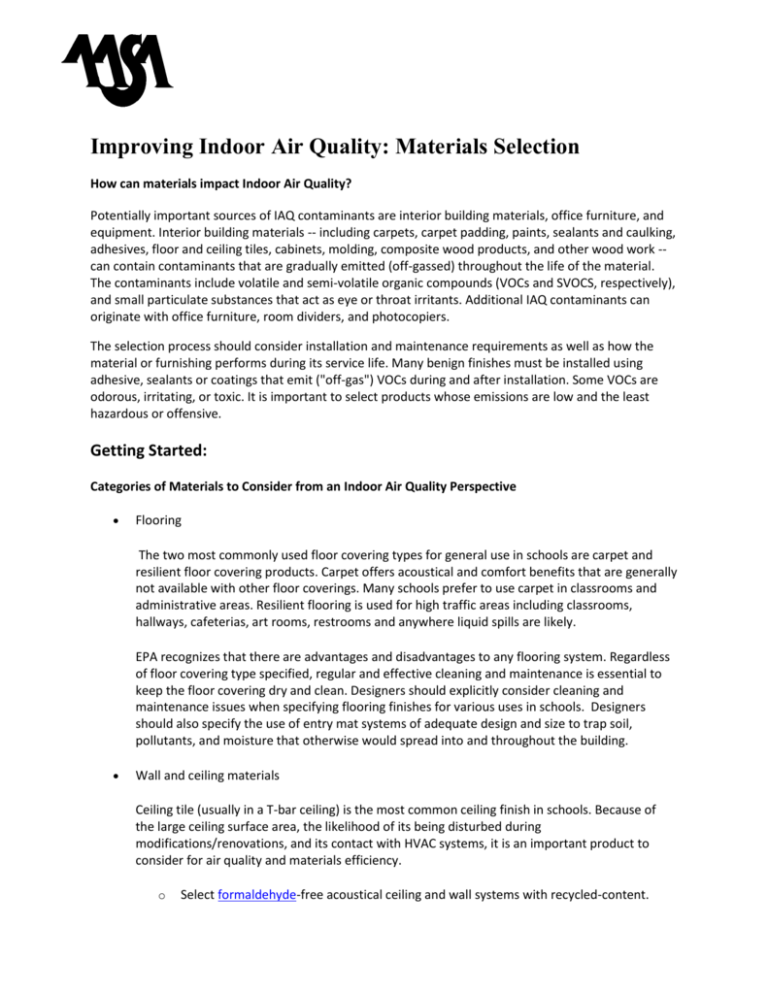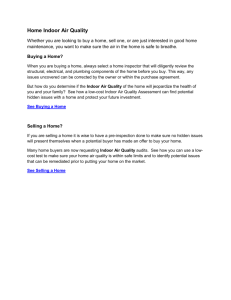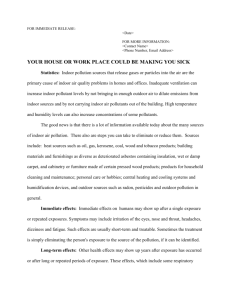Improving Indoor Air Quality: Materials Selection How can materials
advertisement

Improving Indoor Air Quality: Materials Selection How can materials impact Indoor Air Quality? Potentially important sources of IAQ contaminants are interior building materials, office furniture, and equipment. Interior building materials -- including carpets, carpet padding, paints, sealants and caulking, adhesives, floor and ceiling tiles, cabinets, molding, composite wood products, and other wood work -can contain contaminants that are gradually emitted (off-gassed) throughout the life of the material. The contaminants include volatile and semi-volatile organic compounds (VOCs and SVOCS, respectively), and small particulate substances that act as eye or throat irritants. Additional IAQ contaminants can originate with office furniture, room dividers, and photocopiers. The selection process should consider installation and maintenance requirements as well as how the material or furnishing performs during its service life. Many benign finishes must be installed using adhesive, sealants or coatings that emit ("off-gas") VOCs during and after installation. Some VOCs are odorous, irritating, or toxic. It is important to select products whose emissions are low and the least hazardous or offensive. Getting Started: Categories of Materials to Consider from an Indoor Air Quality Perspective Flooring The two most commonly used floor covering types for general use in schools are carpet and resilient floor covering products. Carpet offers acoustical and comfort benefits that are generally not available with other floor coverings. Many schools prefer to use carpet in classrooms and administrative areas. Resilient flooring is used for high traffic areas including classrooms, hallways, cafeterias, art rooms, restrooms and anywhere liquid spills are likely. EPA recognizes that there are advantages and disadvantages to any flooring system. Regardless of floor covering type specified, regular and effective cleaning and maintenance is essential to keep the floor covering dry and clean. Designers should explicitly consider cleaning and maintenance issues when specifying flooring finishes for various uses in schools. Designers should also specify the use of entry mat systems of adequate design and size to trap soil, pollutants, and moisture that otherwise would spread into and throughout the building. Wall and ceiling materials Ceiling tile (usually in a T-bar ceiling) is the most common ceiling finish in schools. Because of the large ceiling surface area, the likelihood of its being disturbed during modifications/renovations, and its contact with HVAC systems, it is an important product to consider for air quality and materials efficiency. o Select formaldehyde-free acoustical ceiling and wall systems with recycled-content. o Where feasible, sequence work to avoid applying VOC-containing materials in spaces with exposed acoustical surfaces. o Require adequate ventilation during installation of finish materials that emit indoor pollutants. o Consult with the manufacturer before painting/coating any acoustical material. With most ceiling tiles, for example, the material loses its acoustical properties once it has been painted. o Coordinate placement of lighting fixtures and other equipment in ceilings to provide clear access for inspection and servicing of HVAC system air filters and other components. o Remove any wetted ceiling tiles from the site immediately to avoid mold contamination. Avoid using ceiling tile and sprayed-on ceiling finishes containing asbestos or formaldehyde. Paints & coatings Most conventional paint and coating products off-gas volatile organic compounds (VOCs). These VOCs may be either ingredients that are added to the paint to enhance product performance and shelf life or they can be byproducts of the paint drying process. High quality, "low-toxicity," and "no-VOC" or "low-VOC" paint and coating products are now available. However, such paints may still contain or emit odorous, toxic, or otherwise undesirable compounds, such as formaldehyde and pesticides (i.e., fungicides and bactericides). While a variety of "low-VOC" and "zero-VOC" paints are now available to choose from, they vary in cost, toxicity, and performance. Therefore, paint selection should consider VOC content as well as overall composition and required performance characteristics, including hide ability and durability. "Zero-VOC" or "low-VOC" paints may minimize the indoor air pollution load and may reduce any health risks to both workers and occupants. Water-based acrylic latex paints are generally lower in VOCs than solvent-based paints. Waterbased paints are generally safer to handle and can be cleaned up with water, reducing health risks to workers and minimizing/avoiding hazardous waste. Leftover latex paint may be recyclable, thus reducing waste. Adhesives and sealants Many conventional construction adhesives, sealants, "acoustic" caulking, grouts, and mortars used to bond structural components are solvent based and may off-gas large amounts of volatile organic compounds (VOCs) (including solvents and aromatic hydrocarbons). o Use low VOC, low-toxic water-based, formulations which are now available for many applications. o Specify the least toxic/lowest VOC product suitable for the application and require the installer to use the smallest amount of adhesive necessary to fulfill the manufacturer’s performance specifications for that product. o Engineered wood products School construction frequently uses pressed wood products in a variety of applications. These pressed wood products sometimes contain urea-formaldehyde, which may off-gas formaldehyde over a substantial period of time. Engineered wood products include plywood, particleboard, and medium-density fiberboard (MDF). The principle uses of plywood include decorative wall paneling, doors, cabinets, and furniture. Particleboard is used for subflooring, wall paneling, cabinetry (core materials and shelving), cabinet tops, closet shelving, doors, and furniture. MDF is used in cabinet, furniture, and trim manufacture. Substitutes for these products include composite materials with no ureaformaldehyde; gypsum board for walls; solid wood or metal cabinets; solid wood, metal or plastic furniture; solid wood or metal doors; waferboard, oriented-strand board, iso-board, and phenol-formaldehyde bonded particleboard or plywood. Materials can be obtained with lower potential formaldehyde off-gassing. Material formulation and pre-treatment can be effective in controlling formaldehyde emissions. Quick Tips From an indoor air quality perspective, the designer should generally seek to select materials that: require the use of the least toxic, low-VOC, water-based adhesives and coatings constituents; emit little or no odor; are easy to clean and maintain; and are not susceptible to moisture damage that can foster mold growth. To find more information on improving indoor air quality visit: Tools for Schools the IAQ Tools for Schools Program is a comprehensive resource to help schools maintain a healthy environment in school buildings by identifying, correcting, and preventing IAQ problems. This program offers no-cost, low-cost solutions to reducing indoor environmental pollutants. Reference: EPA IAQ Design www.epa.gov







